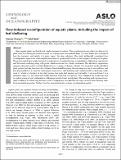| dc.contributor.author | Zhang, Xiaoxia | |
| dc.contributor.author | Nepf, Heidi | |
| dc.date.accessioned | 2021-10-19T16:57:00Z | |
| dc.date.available | 2021-10-19T16:57:00Z | |
| dc.date.issued | 2020-06 | |
| dc.date.submitted | 2020-03 | |
| dc.identifier.issn | 1939-5590 | |
| dc.identifier.uri | https://hdl.handle.net/1721.1/133052 | |
| dc.description.abstract | © 2020 The Authors. Limnology and Oceanography published by Wiley Periodicals LLC on behalf of Association for the Sciences of Limnology and Oceanography. Many aquatic plants are flexible and bend in response to current. This reconfiguration can reduce the drag on the plant, both by reducing the frontal area and by creating a more streamlined shape. Previous studies have considered how the buoyancy and rigidity of a plant impact the drag reduction. This study additionally considered how reconfiguration impacts the sheltering between leaves on a plant and how this, in turn, impacts the drag on the plant. The posture and drag of single-stemmed, leaved plants were studied through a combination of laboratory experiments and theoretical modeling using both plastic Rotala bonsai and live Bacopa caroliniana. The laboratory experiments measured drag and posture on individual plants over a range of channel velocity. The theoretical model calculated plant posture and drag based on a force balance that included buoyancy, the restoring force due to stem stiffness, and leaf drag modified to account for sheltering between leaves. Leaf sheltering was characterized by a sheltering coefficient, Cs, which is a function of the plant posture, leaf angle, leaf spacing, and leaf width. Cs decreased from 1 to a minimum value, Cs0, associated with a fully deflected, horizontal stem posture. Once validated, the model was used to explore a range of leaf configurations, following examples found in real plants. The modeling and experiments revealed conditions for which drag increased with reconfiguration, and also that the drag reached a finite, limiting value for horizontal stem posture. Neither trend has been described in previous reconfiguration models. | en_US |
| dc.language.iso | en | |
| dc.publisher | Wiley | en_US |
| dc.relation.isversionof | 10.1002/LNO.11542 | en_US |
| dc.rights | Creative Commons Attribution 4.0 International license | en_US |
| dc.rights.uri | https://creativecommons.org/licenses/by/4.0/ | en_US |
| dc.source | Wiley | en_US |
| dc.title | Flow‐induced reconfiguration of aquatic plants, including the impact of leaf sheltering | en_US |
| dc.type | Article | en_US |
| dc.identifier.citation | Zhang, X. and Nepf, H. (2020), Flow-induced reconfiguration of aquatic plants, including the impact of leaf sheltering. Limnol Oceanogr, 65: 2697-2712 | en_US |
| dc.contributor.department | Massachusetts Institute of Technology. Department of Civil and Environmental Engineering | |
| dc.relation.journal | Limnology and Oceanography | en_US |
| dc.eprint.version | Final published version | en_US |
| dc.type.uri | http://purl.org/eprint/type/JournalArticle | en_US |
| eprint.status | http://purl.org/eprint/status/PeerReviewed | en_US |
| dc.date.updated | 2021-10-19T15:55:49Z | |
| dspace.orderedauthors | Zhang, X; Nepf, H | en_US |
| dspace.date.submission | 2021-10-19T15:55:56Z | |
| mit.journal.volume | 65 | en_US |
| mit.journal.issue | 11 | en_US |
| mit.license | PUBLISHER_CC | |
| mit.metadata.status | Authority Work Needed | en_US |
